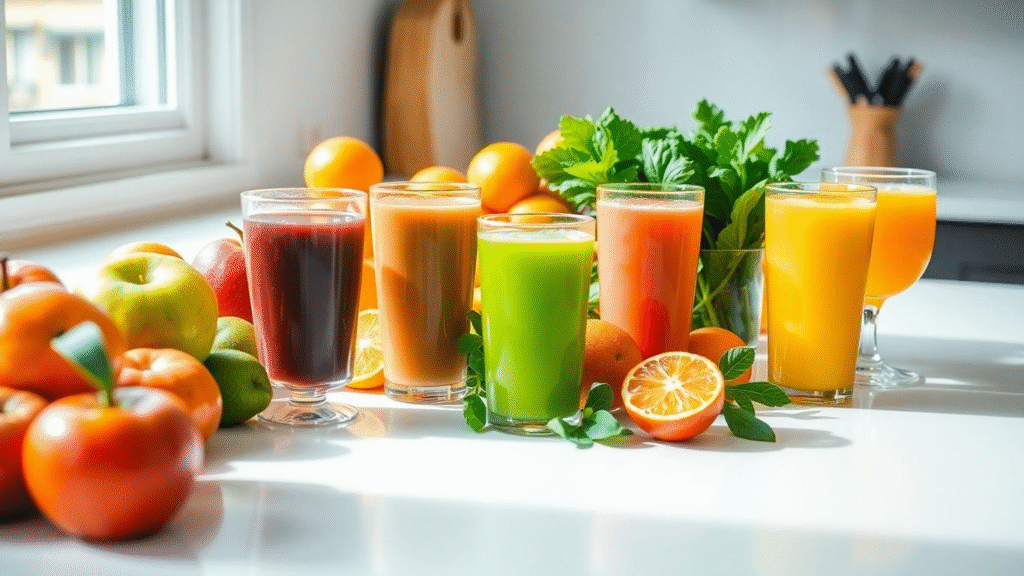Initial Hunger and Cravings
The first day on a juice cleanse often comes with a wave of hunger pangs. It’s normal to find yourself eyeing leftovers or daydreaming about your next proper meal. Cravings can hit hard since meals and snacks are part of daily routines, and suddenly removing solid food leaves a mental and physical gap. For some, the lack of chewing and the repetitive nature of drinking juice every couple hours intensifies these thoughts. By day two, cravings may mellow out for a few people, but they’ll linger for others all the way to the end of the juice cleanse.
Changes in Energy Levels
Energy can swing wildly during a juice cleanse. Many people report feeling sluggish and a bit foggy, especially in the middle of the day. Some notice bursts of energy after each juice, but it’s usually short-lived. Don’t be surprised if you’re tempted to nap in the afternoon or go to bed early. The calorie drop and lack of protein mean the body is trying to adjust and conserve energy. For those used to caffeine, the sudden cut can lead to extra tiredness.
Potential Headaches and Fatigue
Headaches are a common side effect, especially for regular coffee or soda drinkers. When you stop caffeine abruptly during a juice cleanse, the body can react with withdrawal symptoms. Dehydration from not drinking enough water, or just the stress of fewer calories, can also bring on headaches. Fatigue comes with the territory, so expect to feel worn out faster—a brisk walk could suddenly feel like a workout.
Taking a juice cleanse means preparing for some physical discomfort. The body doesn’t get what it’s used to—meals, snacks, caffeine—which often means headaches, tiredness, and cravings stick around for a few days.
Impact on Digestion and Gut Health
Changes in Bowel Movements
Juice cleanses bring a big shift to the bathroom. With only liquids going in, your body has less to process, so stool becomes softer or even watery. Some folks experience more urgent trips, others feel a slowdown. Impact on digestion and gut health is something you notice fast—sometimes even in the first 24 hours. After just a day or two, bathroom routines look totally different from normal eating.
Reduction in Fiber Intake
Most juices used during cleanses are strained of pulp and solids. That means almost all the fiber in fruits and veggies gets tossed out. Low fiber means your gut has less bulk to push waste through. Over a few days, this drop can make it tough to stay regular. People might feel bloated, or the opposite—loose and gassy.
Effects on Gut Bacteria
The bacteria in your gut thrive on a steady supply of varied fiber, resistant starch, and food scraps. When you swap whole foods for just juice, those bacteria start running low on their favorite meals. Over time, this lower diversity can shift the pattern of your gut flora, though short cleanses tend not to wipe everything out. Still, for the days you’re on a juice cleanse, impact on digestion and gut health also means your gut bugs aren’t getting the nutrition they need.
For the short term, these changes aren’t usually dangerous. But your gut and your bathroom habits can definitely feel the switch.
- Expect quick changes in how often (and how urgently) you go.
- You’ll probably miss out on the satisfying feeling that comes from a normal meal.
- Long cleanses could make regular digestion harder after, as your system readjusts back to fiber.
| Factor | Before Cleanse | During Cleanse |
| Fiber Intake | High (whole foods) | Very Low (liquid) |
| Bowel Pattern | Normal | Unpredictable |
| Gut Bacteria | Well-fed | Lower diversity |
Juice Cleanse and Blood Sugar Levels
Blood Sugar Spikes and Drops
A juice cleanse can cause rapid swings in blood sugar. Fruit and vegetable juices usually have a high sugar content but little to no fiber to slow absorption. That means blood sugar spikes after each glass, followed by a quick drop. These ups and downs can leave people feeling jittery, then tired or even faint. This rollercoaster is especially noticeable if someone is used to eating meals with protein or whole grains that steady blood sugar.
The keyword “juice cleanse” is important here because it’s this exact practice that strips the fiber out, changing the way your body handles sugar. If you already have issues managing blood sugar, a juice cleanse can make things worse, not better.
Risks for People with Diabetes
For those living with diabetes or insulin resistance, a juice cleanse brings extra risks. Without enough protein or fat, and with a flood of sweet, fiberless juice, blood glucose can spike way too fast. The body tries to keep up, but it might overshoot and cause hypoglycemia, or low blood sugar, after the insulin surge.
At greatest risk on a juice cleanse:
- People using insulin or other blood glucose–lowering medications
- Anyone with a history of hypoglycemia
- Those who already struggle to keep blood sugar stable
A juice cleanse often isn’t safe for these groups. Always talk to a healthcare provider before drastically changing your diet if you have diabetes.
Symptoms of Low Blood Sugar
Blood sugar drops make themselves known fast for most people. Here are the top signs to watch during a juice cleanse:
- Shakiness or feeling weak
- Dizziness or lightheadedness
- Sweating
- Headache or confusion
If any of these symptoms hit, it’s time to pause the cleanse and get some solid food—and possibly medical help—involved. Juice-only diets are rarely worth the risk for those sensitive to blood sugar changes.
| Potential Symptom | What It Feels Like |
| Shakiness | Hands tremble, feel weak |
| Lightheadedness | Dizzy, near-fainting |
| Sweating | Breaking out in cold sweat |
| Headache/Confusion | Foggy thinking, headache |
A juice cleanse puts your blood sugar on a wild ride, so it’s best to stay tuned in to your body if you choose to try it.
Influence on Metabolism and Muscle Mass
Temporary Slowdown in Digestion
When starting a juice cleanse, people might notice that things just slow down in the stomach. Since juice is easy for the body to break down, the digestive system gets a break from its usual heavy lifting. This means the body isn’t busy digesting solid food, so the whole process pulls back a bit. It’s a short-term drop, though. As soon as regular eating returns, digestion picks up right where it left off.
Risks of Muscle Loss
Juice cleanses don’t offer much in the way of protein, which is bad news for muscle mass. Without enough protein, the body may dip into muscle stores for fuel. Over time, even a few days, this can start to reduce muscle and lean body mass. Folks hoping to lose weight while “protecting” muscle might find the opposite happens. When doing a juice cleanse, the risk of muscle loss goes up—another reason some experts aren’t fans.
Effects on Long-Term Metabolism
A big worry with any drastic diet, especially a juice cleanse, is what happens to metabolism. With fewer calories coming in, the body tries to adjust by burning less. Over more than a few days, this could slow down resting metabolism slightly. There’s no magic here—a juice cleanse makes changes in metabolism that bounce back after eating normal meals again. Still, doing this too often or for long stretches can mess with how the body manages energy.
Here’s a quick breakdown:
| Metabolic Factor | Impact During Juice Cleanse | Reverses After Return to Food? |
| Digestion Speed | Slows down | Yes |
| Muscle Mass | Slight decrease possible | With proper diet, yes |
| Resting Metabolism | Temporary drop | Yes |
If someone is chasing speedy weight loss, a juice cleanse might seem tempting, but the influence on metabolism and muscle mass is usually not what most people are hoping for.
Hydration, Electrolyte Balance, and Kidney Health
Risk of Dehydration
During a juice cleanse, it’s easy to think you’re staying hydrated because you’re drinking a lot of fluid. But not all juices provide the same hydration as water. Some juices, especially those with laxative ingredients or lots of sugar, can actually leave the body more dehydrated. Dehydration is sneaky: thirst, headaches, and dizziness might pop up out of nowhere. It’s smart to drink water in addition to juice, so your hydration levels stay steady.
Potential Electrolyte Imbalances
A juice cleanse can upset the body’s electrolyte balance. Juice alone is often low in sodium, potassium, and magnesium. Over a few days, this can make people feel weak, fatigued, or even lightheaded. Here’s a quick table of potential electrolyte changes to watch:
| Electrolyte | Role in Body | What Can Happen on a Juice Cleanse |
| Sodium | Fluid balance, nerves | Drops quickly, can feel dizzy |
| Potassium | Muscles, heart rhythm | Can go low, muscle cramps possible |
| Magnesium | Nerve, muscle function | Deficiency can cause fatigue |
Keeping an eye on the electrolyte balance means staying alert to these changes, especially during extended cleanses.
Considerations for Kidney Function
For most, a short juice cleanse won’t hurt the kidneys. But high-oxalate juices—think spinach and beet—can be risky, especially for folks with kidney issues. Oxalate is a natural chemical, and too much can really strain kidney function. Unfiltered juice cleanses might overwhelm the kidneys, even for people without pre-existing conditions.
A juice cleanse might sound refreshing, but keeping an eye on hydration, electrolyte balance, and kidney health matters much more than just drinking juice all day. Stay informed, sip water, and be cautious about what goes into the juicer.
Potential Risks of Juice Cleanses
Trying a juice cleanse might sound harmless, but there are several real risks to watch out for. Here’s what really happens when you swap meals for juice:
Malnutrition and Nutrient Deficiency
Juice cleanses mean skipping protein, fat, and other essentials—not just calories. Your body misses out on what it needs for muscle repair, immunity, and brain function. After a couple of days, people often feel dizzy, weak, or foggy-headed. While juices are loaded with some vitamins, they’re low in things like B12, iron, and healthy fats, making malnutrition a genuine risk during an extreme juice cleanse.
Bacterial Infections from Unpasteurized Juice
Not all juice is created equal. Unpasteurized juices can sometimes carry harmful bacteria like E. coli or Salmonella. This isn’t just a theoretical issue: infections can make anyone sick, but especially young children, older adults, or anyone with a weakened immune system. Storing juice too long or not refrigerating it enough also cranks up the risk for bacterial infections—a real buzzkill that can send you straight to the doctor.
Development of Unhealthy Eating Habits
A juice cleanse might seem like a quick health reset, but it can encourage a cycle of bingeing, restricting, and guilt. For some, the urge to “detox” after eating normally turns into yo-yo dieting or even disordered eating habits. Instead of building a healthy relationship with food, juice cleanses can make eating feel like a punishment or a reward.
Common Warning Signs
- Feeling obsessed with food or weight right after a cleanse
- Repeatedly jumping from extreme restriction to overeating
- Viewing solid foods as “bad” or “toxic”
Choosing a sustainable, balanced routine beats a week-long juice cleanse. Quick fixes usually come with hidden strings attached.
Below is a simple table highlighting key risks of a juice cleanse:
| Risk | What to Watch For |
| Malnutrition | Weakness, fatigue, forgetfulness |
| Bacterial infections | Nausea, cramps, fever |
| Unhealthy eating habits | Binge eating, guilt, restriction |
Remember, the potential risks of juice cleanses tend to outweigh their trendy promises. Taking care with what you put in your body for the long haul is far more effective.
Common Misconceptions About Juice Cleanses
Reality of Detox Claims
Many people see juice cleanse programs as a way to “flush out toxins.” The belief is that drinking only juice clears the body of bad stuff that builds up over time. But here’s the real scoop: the body already has a built-in detox system – the liver and kidneys. No amount of pressed celery will turbocharge these organs. Going on a juice cleanse doesn’t actually push toxins out. The best way to support your natural detox process? Stick with balanced meals, stay hydrated, and avoid extremes.
Sustainability of Weight Loss
Juice cleanse plans are promoted as quick fixes for weight loss, but the reality is a lot less exciting. You might see the number on the scale dip, but it’s mostly water loss and a little muscle, not lasting fat burn. Once regular meals return, that weight tends to sneak right back. Relying on a juice cleanse for long-term results is like using a band-aid for a leaky pipe—it just doesn’t hold up. Lasting change comes from steady habits, not drastic short-term resets.
Detoxification Functions of the Liver and Kidneys
This part is easy to overlook when the next big juice cleanse trend hits. The liver filters out stuff that shouldn’t stay in the bloodstream, while the kidneys help flush waste away as urine. They work nonstop. Extreme juice cleanse routines won’t “boost” their detox superpowers—in fact, skimping on important nutrients by just drinking juice might even make things harder for these organs.
The truth is, a juice cleanse may promise more than it can deliver. Your body’s own organs take care of detoxing if you just give them a good, steady diet and some water.
Key Points to Remember:
- The body’s natural detox system works all day, every day.
- Most juice cleanse weight loss is temporary and can bounce right back.
- Supporting health comes from regular, balanced meals—not strict juice-only plans.
Guidelines for Safer Juice Cleanse Practices

When thinking about a juice cleanse, safety steps matter more than any health claims. No cleanse is worth getting sick over. Let’s lay out how to approach a juice cleanse so you avoid the common pitfalls and keep your body from getting run down.
Best Practices for Preparation and Storage
Start with clean hands and fresh produce. Wash fruits and vegetables under running water, even if you plan to peel them. Cut away and discard any brown or damaged spots. Always use clean equipment—blender, juicer, containers—every time. If you prep juice ahead of time, pour it into airtight containers, pop them in the fridge, and aim to drink them within 24 to 36 hours. Leaving juice out too long is a quick way to invite bacteria.
Quick Checklist for Safe Juice Making:
- Always wash produce thoroughly
- Remove spoiled or bruised spots
- Store juice cold in a sealed, clean bottle
A safe juice cleanse depends on careful preparation and smart storage. A little caution now means fewer regrets later.
Incorporating Light Physical Activity
Days on a juice cleanse should not feel like marathon training. Most people feel lower energy, so dial back exercise to simple movement: walking, stretching, gentle yoga. These activities keep blood moving, help with mood, but won’t push the body too hard when calories are limited. Listen to any unusual signals—if you feel super dizzy or weak during workouts, that’s a sign to rest.
Light Exercises to Try During a Juice Cleanse:
- Easy strolls outdoors or indoors
- Yoga focused on breath and flexibility
- Short stretching sessions
Juice cleanse routines should keep your energy steady, not send it crashing.
Importance of Adequate Sleep
Sleep is non-negotiable on a juice cleanse. Juice cleansing is a stressor, and getting enough rest helps the body recover and adapt. Most people do best with 7–9 hours of sleep a night, but on a cleanse, it might be helpful to get a little extra. Power down electronics earlier and allow yourself proper wind-down time, since sleep supports metabolism and mood during these calorie-light days. If you’re restless, try a calm evening routine—quiet reading, stretching, dim lights.
Juice cleanse safety improves with proper rest and recovery time. Let your body restore while you’re taking a break from solid food.
Conclusion
Juice cleanses might sound like a quick fix for feeling lighter or hitting the reset button, but the reality is a bit more complicated. While you might notice some short-term changes—like less bloating or a drop on the scale—these effects usually don’t last once you go back to eating regular meals. The body already has organs like the liver and kidneys that handle detoxing just fine, so there’s no need to rely on juice alone. Plus, skipping out on protein, fats, and fiber can leave you feeling tired, hungry, and even mess with your blood sugar. For most people, focusing on a balanced diet with plenty of fruits and veggies, along with other food groups, is a better way to support your health. Juice can be a tasty addition to your routine, but it’s not a magic solution. If you’re thinking about making big changes to your diet, it’s always smart to check in with a healthcare professional first.



